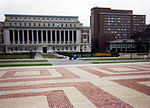Rat Rock (Morningside Heights)
Rat Rock is an outcrop of Manhattan schist between 600 and 604 West 114th Street in the Morningside Heights neighborhood of Manhattan, New York City. The boulder measures approximately 30 feet (9.1 m) high and 100 feet (30 m) long; it is notable as one of the only remaining such rocks remaining in Manhattan's street grid. It was named Rat Rock for the large number of rats nesting in it, similar to the other Rat Rock in Central Park. The row houses around it were built in the 1890s, when land in Manhattan was significantly less valuable. Though the land on which it sits has greatly appreciated in value, Columbia University, which owns Rat Rock along with most of West 114th Street, has no plans to remove it, as it has been estimated that removing the rock could cost hundreds of thousands of dollars. The fence around it was placed by the university in order to prevent vandalism. Columbia professor Andrew Dolkart described it as "an extraordinary survivor" of New York City's development, because it "hints at the geology of the city", and The New York Times labelled it one of New York's "most amazing natural wonders".
Excerpt from the Wikipedia article Rat Rock (Morningside Heights) (License: CC BY-SA 3.0, Authors).Rat Rock (Morningside Heights)
West 114th Street, New York Manhattan
Geographical coordinates (GPS) Address Nearby Places Show on map
Geographical coordinates (GPS)
| Latitude | Longitude |
|---|---|
| N 40.806888888889 ° | E -73.9655 ° |
Address
West 114th Street 604
10025 New York, Manhattan
New York, United States
Open on Google Maps






